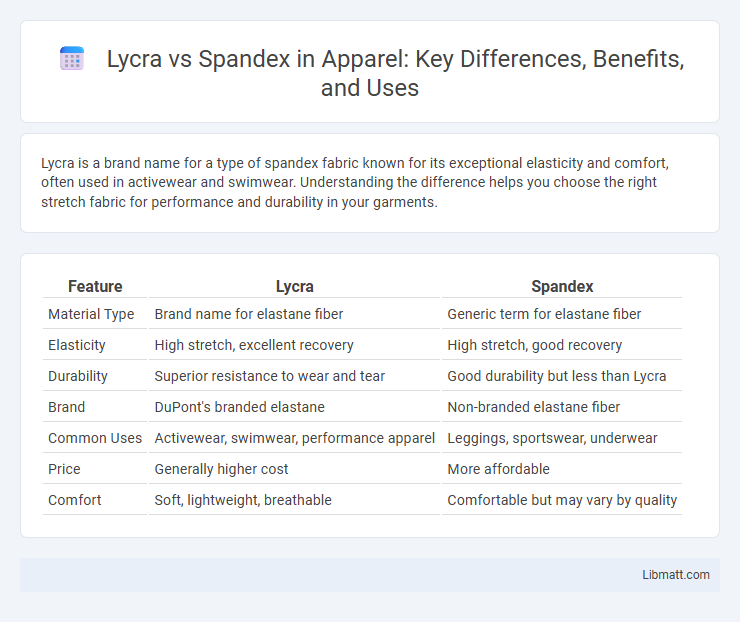Lycra is a brand name for a type of spandex fabric known for its exceptional elasticity and comfort, often used in activewear and swimwear. Understanding the difference helps you choose the right stretch fabric for performance and durability in your garments.
Table of Comparison
| Feature | Lycra | Spandex |
|---|---|---|
| Material Type | Brand name for elastane fiber | Generic term for elastane fiber |
| Elasticity | High stretch, excellent recovery | High stretch, good recovery |
| Durability | Superior resistance to wear and tear | Good durability but less than Lycra |
| Brand | DuPont's branded elastane | Non-branded elastane fiber |
| Common Uses | Activewear, swimwear, performance apparel | Leggings, sportswear, underwear |
| Price | Generally higher cost | More affordable |
| Comfort | Soft, lightweight, breathable | Comfortable but may vary by quality |
Introduction to Lycra and Spandex
Lycra and spandex are synthetic fibers known for exceptional elasticity, commonly used in activewear, swimwear, and performance apparel. Both are made from polyurethane polymers, offering superior stretch and shape retention, but Lycra is a trademarked brand by Invista, often associated with higher quality and durability. When selecting fabric for your garment, understanding the subtle differences between Lycra and generic spandex ensures optimal comfort and fit.
The Origins: Lycra vs. Spandex
Lycra and spandex both originate from the development of polyurethane-based elastomer fibers in the 1950s, with spandex being the generic term for this stretchable material. Lycra is a branded version of spandex created by DuPont, known for its enhanced durability and elasticity. Understanding these origins helps you choose fabrics that balance comfort and performance in activewear or stretch garments.
Chemical Composition and Structure
Lycra and spandex are both synthetic fibers composed primarily of polyurethane polymers, characterized by long chains of segmented elastomeric materials that provide exceptional elasticity. The chemical composition involves alternating soft and hard segments, where the soft segments offer stretchability and the hard segments contribute to strength and durability. This segmented block copolymer structure underpins their ability to recover shape and maintain resilience in various textile applications.
Manufacturing Process Comparison
Lycra and spandex share a similar manufacturing process, both being synthetic fibers created through the polymerization of polyurethane. Lycra is a brand name for a type of spandex produced under stricter quality controls, ensuring higher elasticity and durability. The production involves spinning polyurethane fibers into filaments, which are then stretched to multiple times their original length to achieve exceptional stretch and recovery properties.
Key Properties and Performance
Lycra and spandex both offer exceptional elasticity, but Lycra is a trademarked brand known for superior stretch recovery and durability, making it ideal for high-performance activewear. Spandex provides excellent flexibility and moisture-wicking properties, ensuring comfort during intense physical activities. Both materials excel in breathability and resistance to sweat and body oils, but Lycra often delivers enhanced shape retention and longer-lasting wear.
Common Uses and Applications
Lycra and spandex are widely used in activewear, swimwear, and dancewear due to their exceptional stretch and recovery properties. Common applications include sports bras, leggings, and compression garments that require flexibility and durability. You'll find these fabrics in performance apparel designed to enhance movement and comfort during physical activities.
Durability and Longevity
Lycra and spandex share similar durability, as both are made from elastane fibers known for their strength and resistance to wear. Lycra, being a branded form of spandex, often undergoes stricter quality control, resulting in enhanced longevity and better shape retention over time. Choosing garments with Lycra ensures your activewear or swimwear maintains elasticity and appearance even after frequent use and washing.
Comfort and Wearability
Lycra provides exceptional comfort and wearability due to its superior stretch and recovery properties, making garments fit your body seamlessly without losing shape. Spandex, while also highly elastic, may offer slightly less softness but excels in durability and breathability for active wear. Choosing between Lycra and spandex depends on your priorities for stretch, comfort, and long-term garment performance.
Main Differences Between Lycra and Spandex
Lycra and spandex are often used interchangeably but have distinct differences in branding and performance; Lycra is a trademarked brand of spandex fiber known for superior stretch and recovery abilities. Spandex, a synthetic fiber made from polyurethane, offers elasticity and durability widely used in activewear and swimwear, while Lycra is engineered to provide enhanced breathability and moisture-wicking properties. Your choice depends on whether you prioritize a branded fabric with specific performance qualities or a generic stretchy material for various clothing applications.
Choosing the Right Fabric for Your Needs
Lycra and spandex, both known for their exceptional stretch and recovery, differ primarily in brand origin and fabric blends. Lycra, a trademarked brand by DuPont, often signifies higher-quality, durable blends ideal for activewear and performance clothing, while spandex is a generic term used broadly in various textiles. Understanding your needs for comfort, elasticity, and garment durability helps you choose the right fabric to enhance Your clothing experience.
Lycra vs spandex Infographic

 libmatt.com
libmatt.com